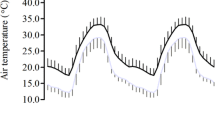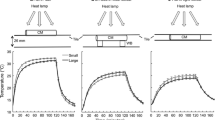Abstract
Field data showing the daily patterns in body temperature (T b) of kangaroos in hot, arid conditions, with and without water, indicate the use of adaptive heterothermy, i.e. large variation in T b. However, daily T b variation was greater in the Eastern Grey Kangaroo (Macropus giganteus), a species of mesic origin, than in the desert-adapted Red Kangaroo (Macropus rufus). The nature of such responses was studied by an examination of their thermal adjustments to dehydration in thermoneutral temperatures (25°C) and at high temperature (45°C) via the use of tame, habituated animals in a climate chamber. At the same level of dehydration M. rufus was less impacted, in that its T b changed less than that for M. giganteus while it evaporated significantly less water. At a T a of 45°C with water restriction T b reached 38.9 ± 0.3°C in M. rufus compared with 40.2 ± 0.4°C for M. giganteus. The ability of M. rufus to reduce dry conductance in the heat while dehydrated was central to its superior thermal control. While M. giganteus showed more heterothermy, i.e. its T b varied more, this seemed due to a lower tolerance of dehydration in concert with a strong thermal challenge. The benefits of heterothermy to M. giganteus were also limited because of thermal (Q10) effects on metabolic heat production and evaporative heat loss. The impacts of T b on heat production were such that low morning T b’s seen in the field may be associated with energy saving, as well as water saving. Kangaroos respond to dehydration and heat similarly to many ungulates, and it is apparent that the accepted notions about adaptive heterothermy in large desert mammals may need revisiting.






Similar content being viewed by others
References
Australian Government Bureau of Meteorology (2001) Map of climate zones of Australia. http://www.bom.gov.au/climate/how/newproducts/images/zones/.shtml. Viewed January 2007
Baker MA, Doris PA (1982) Effect of dehydration on hypothalamic control of evaporation in the cat. J Physiol (Lond) 322:457–468
Blaney CE, Dawson TJ, McCarron HCK, Buffenstein R, Krockenberger AK (2000) Water metabolism and renal function and structure in eastern grey kangaroos (Macropus giganteus): responses to water deprivation. Aust J Zool 48:335–345
Brown GD, Dawson TJ (1977) Seasonal variations in the body temperatures of unrestrained kangaroos (Macropodidae: Marsupialia). Comp Biochem Physiol. 56A:59–67
Caughley G, Brown B, Dostine P, Grice D (1984) The grey kangaroo overlap zone. Aust Wildl Res 11:1–10
Dawson TJ (1973) Thermoregulatory responses of the arid zone kangaroos, Megaleia rufa and Macropus robustus. Comp Biochem Physiol 46A:153–169
Dawson TJ (1995) Kangaroos: biology of the largest marsupials. University of New South Wales Press, Sydney
Dawson T, Schmidt-Nielsen K (1966) Effect of thermal conductance on water economy in the Antelope Jack Rabbit, Lepus alleni. Cell Physiol 63:463–471
Dawson TJ, Robertshaw D, Taylor CR (1974) Sweating in the kangaroo: a cooling mechanism during exercise, but not in the heat. Am J Physiol 227:494–498
Dawson TJ, Blaney CE, Munn AJ, Krockenberger A, Maloney SK (2000a) Thermoregulation by kangaroos from mesic and arid habitats: influence of temperature on routes of heat loss in eastern grey kangaroos (Macropus giganteus) and red kangaroos (Macropus rufus). Physiol Biochem Zool 73:374–381
Dawson TJ, Munn AJ, Blaney CE, Krockenberger A, Maloney SK (2000b) Ventilatory accommodation of oxygen demand and respiratory water loss in kangaroos from mesic and arid environments, the eastern grey kangaroo (Macropus giganteus) and the red kangaroo (Macropus rufus). Physiol Biochem Zool 73:382–388
Dawson TJ, McTavish KJ, Ellis BA (2004a) Diets and foraging behaviour of red kangaroos and eastern grey kangaroos in the arid shrub land: is feeding behaviour involved in the range expansion of the eastern grey kangaroo in the arid zone? Aust Mammal 26:169–178
Dawson TJ, Mifsud B, Raad MC, Webster KN (2004b) Aerobic characteristics of red kangaroo muscles: is a high aerobic capacity matched by muscle mitochondrial and capillary morphology as in placental mammals. J Exp Biol 207:2811–2821
Dawson TJ, McTavish KJ, Munn AJ, Holloway J (2006) Water use and the thermoregulatory behaviour of kangaroos in arid regions: insights into the colonisation of arid rangelands in Australia by the Eastern Grey Kangaroo (Macropus giganteus). J Comp Physiol B 176:45–53
Denny MJS (1975) The occurrence of the eastern grey kangaroo (Macropus giganteus Shaw) west of the Darling River. Search (Sydney) 6:89–90
Denny MJS, Dawson TJ (1977) Kidney structure and function of desert kangaroos. J Appl Physiol 42:636–642
Dmi’el R (1986) Selective sweat secretion and panting modulation in dehydrated goats. J Therm Biol 11:157–159
Dmi’el R, Robertshaw D (1983) The control of panting and sweating in the black Bedouin goat: a comparison of two modes of imposing a heat load. Physiol Zool 56:404–411
Finch VA, Robertshaw D (1979) Effect of dehydration on thermoregulation in eland and hartebeest. Am J Physiol 237:R192–R196
Fuller A, Maloney SK, Mitchell G, Mitchell D (2004) The eland and the oryx revisited: body and brain temperatures of free-living animals. Int Congr Ser 1275:275–282
Hill RW (1972) Determination of oxygen consumption by use of the paramagnetic oxygen analyzer. J Appl Physiol 33:261–263
Maloney SK, Dawson TJ (1994) Ventilatory accommodation of oxygen demand and respiratory water loss in a large bird, the emu (Dromaius novaehollandiae), and a re-examination of ventilatory allometry for birds. J Comp Physiol B 164:473–481
Maloney SK, Fuller A, Kamerman PR, Mitchell G, Mitchell D (2004) Variation in body temperature in free-ranging western grey kangaroos Macropus fuliginosus. Aust Mamm 26:135–144
McCarron HCK, Buffenstein R, Fanning FD, Dawson TJ (2001) Free-ranging heart rate, body temperature and energy metabolism in eastern grey kangaroos (Macropus giganteus) and red kangaroos (Macropus rufus) in the arid regions of south east Australia. J Comp Physiol B 171:401–411
McCullough DR, McCullough Y (2000) Kangaroos in outback Australia: comparative ecology and behaviour of three coexisting species. Columbia University Press, New York, USA
Mitchell D, Maloney SK, Jessen C, Laburn HP, Kamerman PR, Mitchell G, Fuller A (2002) Adaptive heterothermy and selective brain cooling in arid-zone animals. Comp Physiol Biochem B 131:571–585
Needham AD, Dawson TJ (1984) Influence of environmental temperature on the blood flow distribution in the Red Kangaroo, Macropus rufus. In: Hales JRS (Ed) Thermal physiology. Raven Press, New York, pp 275–278
Needham AD, Dawson TJ, Hales JRS (1974) Forelimb blood flow and saliva spreading in the thermoregulation of the red kangaroo, Megaleia rufa. Comp Biochem Physiol 49A:555–565
Ostrowski S, Williams JB (2006) Heterothermy of free-living Arabian sand gazelles (Gazzella subgutturosa marica) in a desert environment. J Exp Biol 209:1421–1429
Ostrowski S, Williams JB, Ismael K (2003) Heterothermy and water economy of free living Arabian oryx (Oryx leucoryx). J Exp Biol 206:1471–1478
Refinetti R, Menaker M (1992) The circadian rhythm of body temperature. Physiol Behav 51:613–637
Robertshaw D, Dmi’el R (1983) The effect of dehydration on the control of panting and sweating in the black Bedouin goat. Physiol Zool 56:412–418
Schmidt-Nielsen K, Schmit-Nielsen B, Jarnum SA, Houpt TR (1957) Body temperature of the camel and its relation to water economy. Am J Physiol 188:103–112
Schmidt-Nielsen K, Crawford EC, Newsome AE, Rawson KS, Hammel HT (1967) Metabolic rate of camels: effect of body temperature and dehydration. Am J Physiol 212:341–346
Schmidt-Nielsen K, Dawson TJ, Hammel HT, Hinds D, Jackson DC (1965) The jack rabbit—a study in desert survival. Hvalradets Skrifter 48:125–142
Schroter RC, Robertshaw D, Baker MA, Shoemaker VH, Holmes R, Schmidt-Nielsen K (1987) Respiration in heat stressed camels. Respir Physiol 70:97–112
Taylor CR (1970a) Strategies of temperature regulation: effect on evaporation in East African ungulates. Am J Physiol 219:1131–1135
Taylor CR (1970b) Dehydration and heat: effects on temperature regulation of East African ungulates. Am J Physiol 219:1136–1139
Weast RC, Astle MJ (1983) CRC handbook of chemistry and physics. CRC Press, Boca Raton
Young BA, Fenton TW, McLean JA (1984) Calibration methods in respiratory calorimetry. J Appl Physiol 56:1120–1125
Acknowledgments
This research was funded in part by an Australian Research Council grant to T.J.D. Kangaroos were held under the provisions of license (A18) from the New South Wales National Parks and Wildlife Service. The Animal Care and Ethics Committee of the University of New South Wales gave approval for the study (ACEC 97/100). Dr. R. Buffenstein and F.D. Fanning gave much assistance during the field study, while Dr. A. Munn and Dr. A. Krockenberger provided valued assistance during the laboratory investigation.
Author information
Authors and Affiliations
Corresponding author
Additional information
Communicated by I.D. Hume.
Rights and permissions
About this article
Cite this article
Dawson, T.J., Blaney, C.E., McCarron, H.C.K. et al. Dehydration, with and without heat, in kangaroos from mesic and arid habitats: different thermal responses including varying patterns in heterothermy in the field and laboratory. J Comp Physiol B 177, 797–807 (2007). https://doi.org/10.1007/s00360-007-0176-1
Received:
Revised:
Accepted:
Published:
Issue Date:
DOI: https://doi.org/10.1007/s00360-007-0176-1




